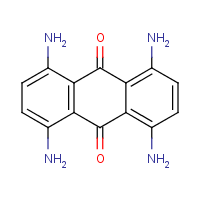Disperse Blue 1
Agent Name
Disperse Blue 1
CAS Number
2475-45-8
Formula
C14-H12-N4-O2
Major Category
Dyes

Synonyms
1,4,5,8-Tetraamino-9,10-anthracenedione; 1,4,5,8-Tetraaminoanthraquinone; 1,4,5,8-Tetraminoanthraquinone; 9,10-Anthracenedione, 1,4,5,8-tetraamino-; Acetate Blue 6; Acetate Blue G; Acetoquinone Blue L; Acetoquinone Blue R; Acetylon Fast Blue G; Amacel Blue GG; Amacel Pure Blue B; Anthraquinone, 1,4,5,8-tetraamino-; Anthraquinone, 1,4,5,8-tetramino-; Artisil Blue SAP; Artisil Blue SAP Conc; Brasilazet Blue GR; C.I. 64500; C.I. Disperse Blue 1; C.I. Solvent Blue 18; CI 64500; CI Disperse Blue 1; CI Solvent Blue 18; Celanthrene Pure Blue BRS; Celliton Blue BB-CF; Celliton Blue Extra; Celliton Blue G; Celliton Blue GA-CF; Cibacet Sapphire Blue G; Cibacete Sapphire Blue G; Cilla Blue Extra; Diacelliton Fast Blue R; Disperse Blue NO 1; Dracet Sapphire Blue G; Duranol Brilliant Blue CB; Fenacet Blue G; Grasol Blue 2GS; Kayalon Fast Blue BR; Microsetile Blue EB; Miketon Fast Blue; Miketon Fast Blue B; Nacelan Blue G; Neosetile Blue EB; Nyloquinone Blue 2J; Oracet Sapphire Blue G; Perliton Blue B; Serinyl Blue 2G; Serinyl Blue 3G; Serinyl Blue 3GN; Setacyl Blue 2GS; Setacyl Blue 2GS II; Solvent Blue 18; Supracet Brilliant Blue 2GN; Supracet Deep Blue R; [ChemIDplus]
Category
Anthraquinone Dyes
Description
Blue-black solid; [HSDB] Deep blue powder; [MSDSonline]
Sources/Uses
Used as dye for sheepskins, furs, thermoplastic resins, acetate, nylon, polyester, other synthetics, and semi-permanent hair colors (in the US); [HSDB]
Comments
Anthraquinones are toxic by ingestion: vomiting, diarrhea, kidney and liver damage, and coma; Deaths have been reported after children ingested Rhamnus berries; Disperse Blue 1 caused a high incidence of bladder stones and hyperplasia in high-dose feeding studies of mice for 2 years; [HSDB] An irritant; May cause serious eye injury; May cause skin sensitization; [eChemPortal: ESIS] A skin and eye irritant; May cause serious eye injury; May cause skin sensitization; Targets the bladder; [MSDSonline]
Restricted
Banned in UE for garment dyeing because potential skin sensitizer; [Ullmann]
Biomedical References
Exposure Assessment
Vapor Pressure
1.8E-08 mm Hg
Adverse Effects
Skin Sensitizer
Yes
Hepatotoxin
Hepatoxic (a) from occupational exposure (secondary effect) or (b) in animal studies or in humans after ingestion
IARC Carcinogen
Possible (2b)
NTP Carcinogen
Anticipated human carcinogen
Diseases, Processes, and Activities Linked to This Agent
Diseases
Occupational diseases associated with exposure to this agent:
Processes
Industrial Processes with risk of exposure: